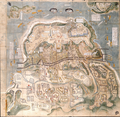The Hara Castle (原城, Hara-jō) was a Sengoku period Japanese castle cemetery located in the Minami-Arima neighbourhood of city of Minamishimabara, Nagasaki Prefecture Japan. Its ruins were designated a National Historic Site of Japan in 1938.[1]
Overview
Hara Castle is located in the southern part of the Shimabara Peninsula. It was built in 1496 by Arima Takazumi on a hill jutting out into the Ariake Sea as a subsidiary castle of Hinoe Castle. At the end of the 16th century, Arima Harunobu, who had gained knowledge of the castles of the Korean Peninsula and Hizen Nagoya Castle during the Japanese invasions of Korea (1592–1598), rebuilt the castle as his main stronghold. Jesuit records have confirmed that at least the main citadel, complete with stone walls, was built between 1599 and 1604.The work at this time transformed it into a castle of the Azuchi-Momoyama period with a tiled roof, and the main, second, third, Amakusa, and outward citadels. The stone walls, square moat, and foundations of the tenshu tower that remain today are from this renovation. After the Arima clan was transferred to Nobeoka Domain in Hyuga Province in 1616, Matsukura Shigemasa entered Hinoe Castle, but due to the influence of the "One Castle per Province Law", he abandoned the inconvenient Hinoe Castle and built Shimabara Castle as his stronghold. At this time, Hara Castle was also abandoned, and although some the stone walls were cannibalised and some structures were relocated for the construction of Shimabara, but it is believed that the stone walls and many buildings (including its massive main gate and several yagura turrets were left behind. Therefore, during the Shimabara Rebellion from 1637 to 1638, rebels were able to successfully barricade themselves in the abandoned Hara Castle for many months against the forces of the Tokugawa shogunate. After the Shimabara Rebellion, the shogunate demolished the stone walls and other structures remaining at the site of the castle. [2]
During various archaeological excavations on the site, the remains of rebels who either fell in battle or were executed afterwards, lead bullets, rosaries and crucifixes were unearthed.[2] In the 2000 excavation, the remains of one of the largest castle gates in Japan were confirmed. The gate was almost a square, measuring 90 by 80 meters east to west. The foundations of the building believed to have been the residence of Amakusa Shiro was also identified. There are remains of an escape route on the Ariake Sea side of the castle, which was investigated by local historians after it collapsed in heavy rains in 1963, but it is not known whether the escape route was built when the castle was built or dug during the Shimabara Rebellion.
On April 6, 2017, the ruins of Hara Castle were selected as one of the Continued Top 100 Japanese Castles in 2017.[3]
On June 30, 2018 Hara Castle along with 11 other sites linked to Catholic persecution in Japan, was added to the UNESCO World Heritage List.[4][5]
The castle site is about 28 kilometers southwest of Shimabarakō Station on the Shimabara Railway Line.
-
Map of the Shimabara Rebellion
-
Ruins of Hara Castle from the sea
-
Remnants of an escape route
See also
References
- ^ "原城跡" (in Japanese). Agency for Cultural Affairs. Retrieved December 20, 2023.
- ^ a b Isomura, Yukio; Sakai, Hideya (2012). (国指定史跡事典) National Historic Site Encyclopedia. 学生社. ISBN 4311750404.(in Japanese)
- ^ "続日本100名城" (in Japanese). 日本城郭協会. 29 November 2017. Retrieved 23 August 2019.
- ^ "Hidden Christian Sites in the Nagasaki Region".
- ^ "UNESCO adds Japanese sites linked to persecution of Christians to World Heritage list". July 2018. Archived from the original on 2018-07-01. Retrieved 2018-06-30.
External links
![]() Media related to Hara Castle at Wikimedia Commons
Media related to Hara Castle at Wikimedia Commons
- Nagasaki Prefecture home page(in Japanese)
- Minamishimabara home page(in Japanese)






Recent Comments